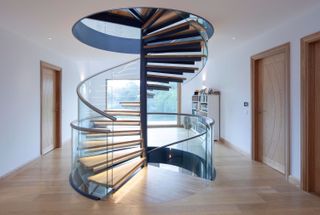Choosing a Spiral, Curved or Cantilevered Staircase
Let your imagination take flight by planning a staircase with a twist that will be a showpiece in your home. Sponsored by Spiral UK

Content supplied by Spiral UK
Your stairs are more than just a straight route up from floor a to floor b. By choosing an unusual shape, it can add real design flare to your home that elevates it beyond its practical purpose.
Whether you choose a contemporary look with glass sides that let light pour through, the timelessness of elegantly carved wood, or clever cantilevered steps that appear as if the treads are floating, the staircase – be it at the front, middle or side of your home – can be a real centrepiece.
Curved and spiral stairs have a more dramatic impact than conventional staircases, and can be created bespoke. We look at some of the options.
Staircase Designs and Considerations
Spiral staircases
These rotate around a central core pole in a circular or corkscrew effect as they turn through floors. They can go in a clockwise or anti-clockwise direction according to the side you want to enter and exit from.
A versatile design, this option is often used to save space. The compact style can make moving large furniture between floors tricky, however, and they are less suitable for people with limited mobility.

弯曲或螺旋楼梯
Curved staircase designs are made up of helical, elliptical (oval) and helix styles and don’t have a core pole. A helical staircase follows a gentle arc in a continuous 'C'. Elliptical styles change radius part way down and form an oval or egg shape.
Helix designs are the same as an elliptical staircase. The treads tend to be wider than on spiral staircases, making more foot room as you go up or down.
The intricacies of designing and installing a curved staircase means it’s likely to cost more and take longer to build than a spiral staircase.

Cantilever staircases
The open riser treads (with a clear gap between them) appear to be floating in a contemporary cantilever style of staircase. The support holding the stairs is normally hidden in a wall, although it is possible to attach the treads to a glass stringer on either side to achieve a similar ‘floating’ effect but without using a wall.

Structural implications
In any of these more unusual designs, it is important to discuss your plans with a structural engineer to make sure the stairs can be properly supported and won’t affect the floors they connect. The location and use of the stair will have an impact on building regulations.
Budget
A bespoke spiral staircase can start at £10,000 while a helical design is likely to cost more.

Staircase Terms and Style Options
- 踏板: Literally what you tread on. On curved and cantilever stairs they can have open or closed risers, be tapered on the rise or splay as you descend. They can be made from steel and clad or inlaid with timber, vinyl, tiles or stone. Solid treads can be made from timber, stone, concrete and even glass.
- 立管: The back of the step between the treads. When they are open, the gap cannot be more than 100mm to prevent small children slipping through.
- Stringers: The sides of the staircase that the treads and risers fit into can be shaped in different ways. Saw tooth-effect stringers are cut out to reflect the shape of the tread and riser on one side and closed underneath. Zig zag stringers are cut in a ‘zig zag’ and follow the tread and riser on both the top and bottom of the stringer.
- Balustrade: The vertical uprights, balusters, or spindles that make up the staircase railings. Traditionally these can be ornate wood or metal spindles or timber clad. Modern options include full-height steel sheet or structured glass. Inner and outer balustrades can be styled differently – the inner balustrade might be glass while the outer is full-height plaster with handrails.
- Handrails:一个援助来平衡你上下楼梯,走these can be inset, oval, circular or square. They connect to the balustrade or wall, and in spiral staircases, also fit to the core pole. Satin polished stainless steel is a popular choice with glass and spiral staircases as the material can be fabricated in a curve. Timber handrails can have decorative finishes, such as scrolls or monkey tails. Handrails can even be powdered-coated or wrapped in materials like rope or leather to suit your scheme
Spiral UK(opens in new tab)is the leading manufacturer of custom-made spiral, helical and cantilever staircases in the UK with more than 30 years’ experience. It offers a full in-house made to measure service, with all stairs made bespoke by craftsmen in their factory in Helston, Cornwall, and installed by teams of fitters across the UK. This approach ensures a high-quality and timely manufacture, delivery and fitting of staircases for customers. Spiral UK can also offer advice and guidance on what to consider when designing a feature staircase for the home.
For more details, visit theSpiral UK website(opens in new tab).
Get the Homebuilding & Renovating Newsletter
Bring your dream home to life with expert advice, how-to guides and design inspiration, direct to your inbox.
Thank you for signing up to Homebuilding. You will receive a verification email shortly.
There was a problem. Please refresh the page and try again.
